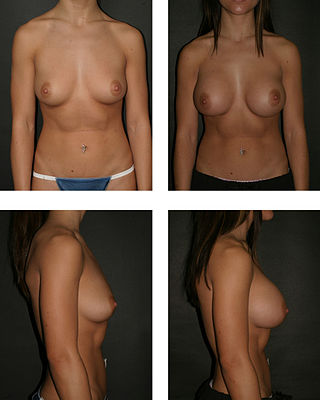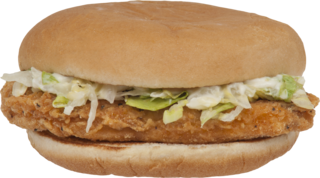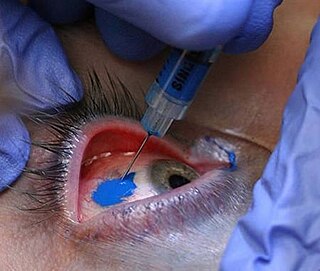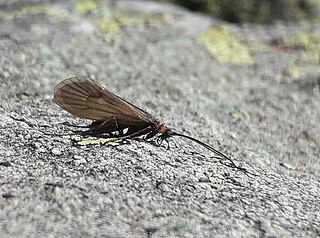
Botulinum toxin, or botulinum neurotoxin, is a highly potent neurotoxic protein produced by the bacterium Clostridium botulinum and related species. It prevents the release of the neurotransmitter acetylcholine from axon endings at the neuromuscular junction, thus causing flaccid paralysis. The toxin causes the disease botulism. The toxin is also used commercially for medical and cosmetic purposes.

A bagel is a bread roll originating in the Jewish communities of Poland. Bagels are traditionally made from yeasted wheat dough that is shaped by hand into a torus or ring, briefly boiled in water, and then baked. The result is a dense, chewy, doughy interior with a browned and sometimes crisp exterior.

Breast augmentation and augmentation mammoplasty is a cosmetic surgery technique using breast-implants and fat-graft mammoplasty techniques to increase the size, change the shape, and alter the texture of the breasts. Augmentation mammoplasty is applied to correct congenital defects of the breasts and the chest wall. As an elective cosmetic surgery, primary augmentation changes the aesthetics – of size, shape, and texture – of healthy breasts.

The McChicken is a chicken sandwich sold by the international fast food restaurant McDonald's. In some countries, such as Australia, India, New Zealand, and the UK, it is considered to be a chicken burger, especially given it is not a sandwich as that word is understood in some of those non-American varieties of English. It consists of a toasted wheat bun, a breaded patty, shredded lettuce and mayonnaise.

The Mazda6 is a mid-size sedan produced by Mazda since 2002, replacing the long-produced Capella/626.

The K-Type is a family of inline-4 automobile engines developed and produced by Renault since 1995. This is an internal combustion engine, four-stroke, with 4 cylinders in line bored directly into the iron block, water cooled, with tree (s) driven overhead camshafts driven by a toothed timing belt and an aluminium cylinder head. This engine is available in petrol and diesel versions, with 8 or 16 valves.

John Maeda is a Vice President of Design and Artificial Intelligence at Microsoft. He is an American technologist and designer whose work explores where business, design, and technology merge to make space for the "humanist technologist."

Toyota Motor Europe (TME) is a subsidiary of Toyota Motor Corporation responsible for company operations in Europe and Western Asia, including Turkey, Russia, Israel, Kazakhstan, and the Caucasus. The company's comprehensive operations encompass research and development, manufacturing, sales, marketing, after-sales, and other various corporate functions. TME, headquartered in Brussels, Belgium, initiated its operations in 1963.

La Carmina is a Canadian blogger, author, journalist, and TV host. She specializes in Goth and Harajuku fashion and Japanese pop culture. She has been described by Qantas as "one of the best-known names in the blogging world, having authored three books and hosting travel segments for international television networks." She also appeared in one of the segments on the Tokyo episode of Bizarre Foods on Travel Channel.

Scleral tattooing is the practice of tattooing the sclera, or white part, of the human eye. Rather than being injected into the tissue, the dye is injected between two layers of the eye, then gradually spreads. The process remains uncommon due to professionals' discomfort performing the procedure and is illegal in the American states Oklahoma and Indiana and the Canadian provinces Ontario and Saskatchewan.

Anna Iriyama is a Japanese actress and YouTuber active in Japan and Mexico. She is a former member of the Japanese idol group AKB48, in which she was a member of Team A. She is represented by the talent agency Ohta Production. She was part of the cast for the telenovela Like and lived in Mexico from 2018 to 2019.

Potamophylax coronavirus is a species of caddisfly in the family Limnephilidae. It is endemic to Kosovo. It was named after the COVID-19 pandemic.

Prost Marketplace is a food cart pod in Portland, Oregon.

Nuvrei is a bakery in Portland, Oregon.

Dingfelder's Delicatessen is a restaurant in Seattle's Capitol Hill neighborhood, in the U.S. state of Washington.

Rubinstein Bagels is a bagel shop with three locations in the Seattle metropolitan area, in the U.S. state of Washington. In Seattle, the business operates in South Lake Union and on Capitol Hill; since 2023, a third location has operated in Redmond.

Eltana is a small chain of Montreal-style bagel shops in Seattle, in the U.S. state of Washington.

















